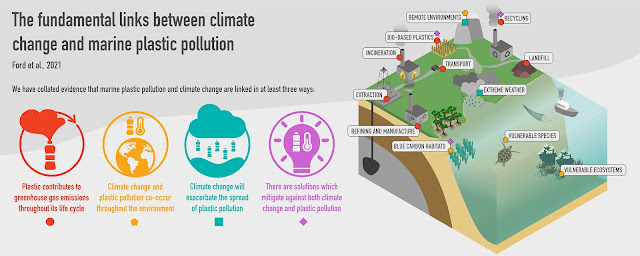Increasing ocean temperatures, rising sea levels, acidification of the oceans, and more severe and frequent weather patterns are all signs of climate change, an important worldwide threat that is expected to worsen. These effects are already being felt in every region of the world. But pollution from plastic displays a uniformly worldwide distribution; it can be found in all ocean regions, including coastal areas to the deeper regions tested to far, as well as in the most inaccessible and vulnerable places on Earth.
Studies on plastic pollution frequently
concentrate on the ocean, its ecosystems, and the living things that inhabited
it; however, the majority of these investigations do not take the extra effect
caused by climate change into account. There are three main ways in which
marine plastic pollution as well as climate change are substantially related.
First, the extraction of fossil fuels and the use of limited resources are
critical for the production of plastic. Aside from the fact that production of
plastic substitutes such as bio-based plastics is expected to rise, their
long-term viability and GHG input is also up for debate, end-of-life (EOL)
procedures for plastic trash have varying and occasionally undetermined
contribution to the world's emissions of greenhouse gases (GHG). Second, as a
result of more severe weather events and floods brought on by a changing
climate, plastic pollution will continue to expand. Third, while there is mounting
evidence that plastic pollution has negative effects on ecosystems as well as
species, global warming itself has clearly disastrous effects on the marine
environment.
With a cumulative yearly growth rate of
8.4 percent, plastic manufacturing climbed from a total of 2 million metric
tons (Mt) during 1950 to an approximated 380 million Mt in 2015. The growing
usage of plastics serves as an example of how necessary affordable,
light-weight substances are in daily life. Over 56 billion Mt of carbon-dioxide-equivalent
(CO2e) in greenhouse gas emissions (GHGs) are projected to be released by
increased plastic manufacturing between 2015 and 2050, accounting for 10–13% of
the existing carbon budget. Three categories may be used to classify plastic's
role in climate change: Production, usage, and transportation of plastics;
improper waste management and deterioration of plastics; and third, bio-based
plastics.
Ecosystems sensitive to climate change are
unstable due to marine plastic pollution and its effects. For instance, coral
bleaching events on coral reefs are happening more often as a result of global
warming and rising ocean temperatures, and are anticipated to become
commonplace in the coming decades on many reefs. Coral bleaching periods
account for widespread coral mortality, changes in species assemblages, and the
loss of several local species. Numerous stressors that collectively put
pressure on coral reefs have proved harmful to their resiliency. Although some
studies have revealed that plastic is bad for coral health, it is still
uncertain to what degree plastic pollution may increase the challenges to
corals posed by climate change. Ingestion of plastic can have a deleterious
impact on gamete fertilization, according to laboratory studies. Decreased
growth and photosynthetic effectiveness, as well as other species-specific
response. Field research has demonstrated that corals are more susceptible to
illness and direct physical harm when there is a plastic waste problem. Plastics
may operate as another stressor, especially at small sizes, even if the direct
consequences of plastic pollution on coral reefs have not been proved when
compared to population-scale climate-driven implications.
About the
Author: Tabinda Zafar is a student of MS environmental science. She is
interested in research on plastic pollution and climate change.
.png)

0 Comments